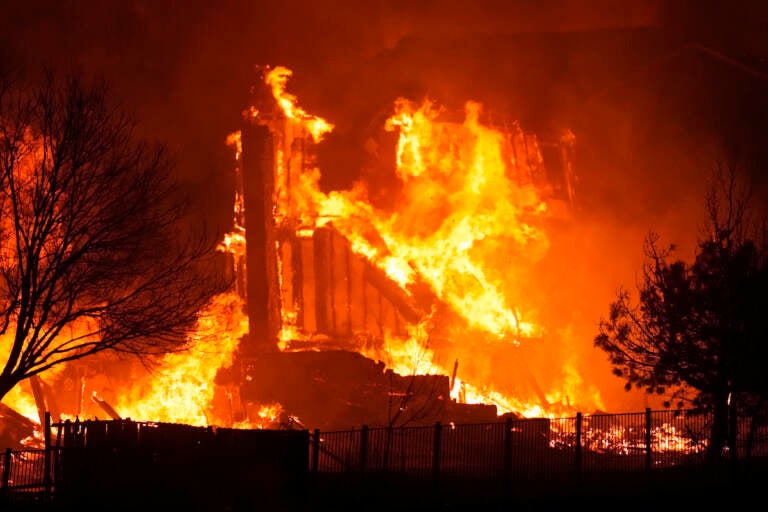‘So many memories’: Over 500 homes feared destroyed by fire
Tens of thousands of Coloradans driven from their neighborhoods by a wind-whipped wildfire are beginning to get a look at the damage done.

Homes burn as wildfires rip through a development near Rock Creek Village Thursday, Dec. 30, 2021, near Broomfield, Colo. (AP Photo/David Zalubowski)
One couple returned home Friday to find the mailbox about the only thing left standing. Charred cars and a burned trampoline lay outside smoldering houses. On some blocks, homes reduced to smoking ruins stood next to ones practically unscathed by the flames.
Colorado residents driven from their neighborhoods by a terrifying, wind-whipped wildfire got their first, heartbreaking look at the damage the morning after, while others could only wait and wonder whether their homes were among the more than 500 feared destroyed.
At least seven people were injured, but remarkably there were no immediate reports of any deaths or anyone missing in the aftermath of the blaze outside Denver.
Cathy Glaab found that her home in the town of Superior where she lives with her husband had been turned into a pile of charred and twisted debris. It was one of seven houses in a row that burned to the ground.
“The mailbox is standing,” Glaab said, trying to crack a smile through tears. She added sadly, “So many memories.”
Despite the devastation, she said they intend to rebuild the house they had since 1998. They love that the land backs up to a natural space, and they have a view of the mountains from the back.
The wildfire erupted Thursday in and around Louisville and Superior, neighboring towns about 20 miles (32 kilometers) northwest of Denver with a combined population of 34,000.
Tens of thousands were ordered to flee as the flames swept over drought-stricken neighborhoods with alarming speed, propelled by guests up to 105 mph (169 kph).
At a Costco in Superior, two store employees came running toward the checkout lines, one of them shouting, “Everyone evacuate, evacuate, evacuate!” said Katrina Peterson, who was inside.
A video she made showed dark skies and whirling debris outside. The falling ash filled her ears, and she had to squint to keep it from getting in her eyes.
The cause of the blaze was under investigation. Emergency authorities said utility officials found no downed power lines around where the fire broke out.
With some roads still closed Friday, people walked back to their homes to get clothes or medicine, turn the water off to prevent the pipes from freezing, or see if they still had a house. They left carrying backpacks and pulling suitcases or wagons down the sidewalk.
David Marks stood on a hillside overlooking Superior with others, using a pair of binoculars and a long-range camera lens to see if his house, and those of his neighbors, were still there, but he couldn’t tell for sure whether his place was OK. He said at least three friends lost their homes.
He had watched from the hillside as the neighborhood burned.
“By the time I got up here, the houses were completely engulfed,” he said. “I mean, it happened so quickly. I’ve never seen anything like that. … Just house after house, fences, just stuff flying through the air, just caught on fire.”
By first light Friday, the towering flames that had lit up the night sky had subsided and the winds had died down. Light snow soon began to fall, and the blaze, which burned at least 9.4 square miles (24 square kilometers), was no longer considered an immediate threat.
“We might have our very own New Year’s miracle on our hands if it holds up that there was no loss of life,” Gov. Jared Polis said, noting that many people had just minutes to evacuate.
The wildfire broke out unusually late in the year, following an extremely dry fall and amid a winter nearly devoid of snow so far.
Boulder County Sheriff Joe Pelle said more than 500 homes were probably destroyed. He and the governor said as many as 1,000 homes might have been lost, though that won’t be known until crews can assess the damage.
“It’s unbelievable when you look at the devastation that we don’t have a list of 100 missing persons,” the sheriff said.
The sheriff said some communities were reduced to just “smoking holes in the ground.” He urged residents to wait for the all-clear to go back because of the danger of fire and fallen power lines.
Sarah Owens, her husband, adult son, and their dog got out of their Superior home within 10 minutes of learning about the evacuation from a Facebook post. But as everyone tried leaving by way of the winding streets of the well-to-do Rock Creek neighborhood, it took them 1 ½ hours to go 2 miles (3.2 kilometers).
“The good news is I think our house may be OK,” Owens said.
But from now on, she said, she plans to have a bag packed in case of another fire.
“I never thought a brush fire could cause this kind of destruction,” Owens said. “I want to stay here. No matter where you live, there are always going to be natural disasters.”
Mike Guanella and his family were relaxing at their home in Superior and looking forward to celebrating a belated Christmas when reports of a nearby grass fire quickly gave way to an order to leave immediately.
Instead of opening presents, Guanella and his wife, their three children, and three dogs were staying at a friend’s house in Denver, hoping that the firefighter friend who told them their home was still standing was right.
“Those presents are still under the tree right now — we hope,” he said.
The two neighboring towns are filled with middle- and upper-middle-class subdivisions with shopping centers, parks, and schools. The area is between Denver and Boulder, home to the University of Colorado.
Scientists say climate change is making weather more extreme and wildfires more frequent and destructive.
Ninety percent of Boulder County is in severe or extreme drought, and it hasn’t seen substantial rainfall since mid-summer. Denver set a record for consecutive days without snow before it got a small storm on Dec. 10, its last snowfall before the wildfires broke out.
WHYY is your source for fact-based, in-depth journalism and information. As a nonprofit organization, we rely on financial support from readers like you. Please give today.







